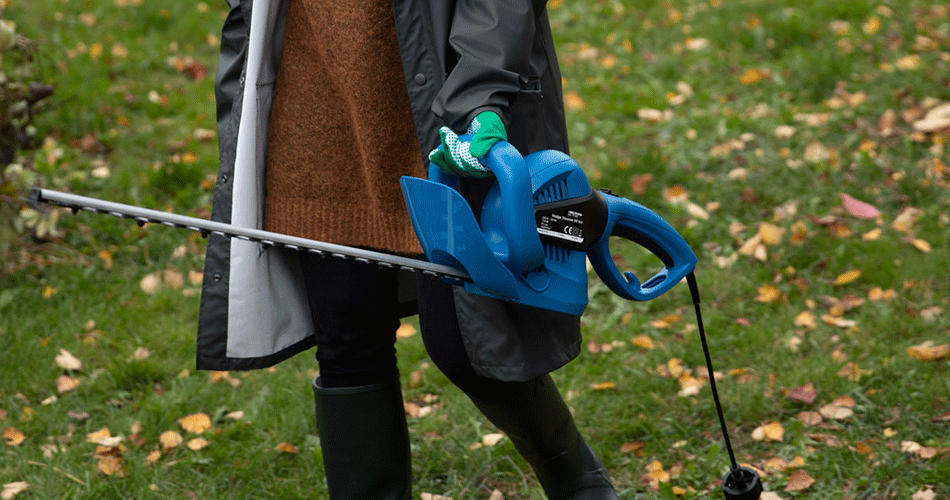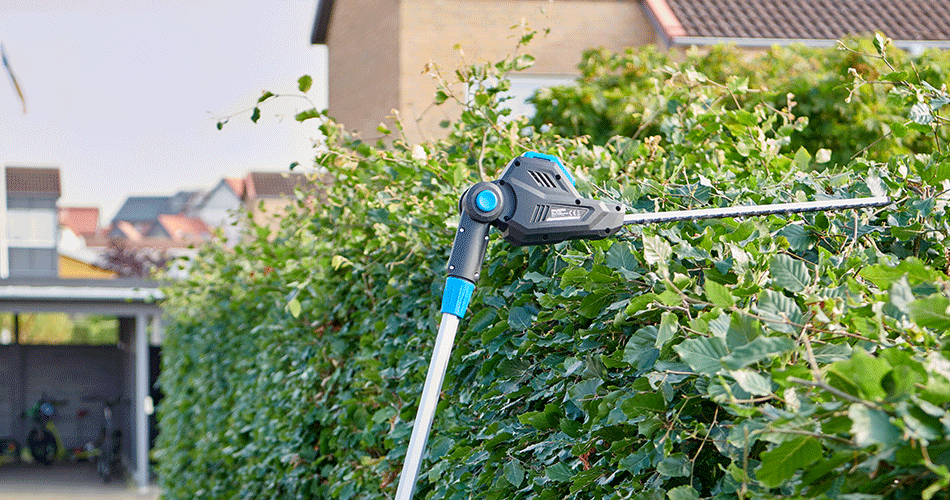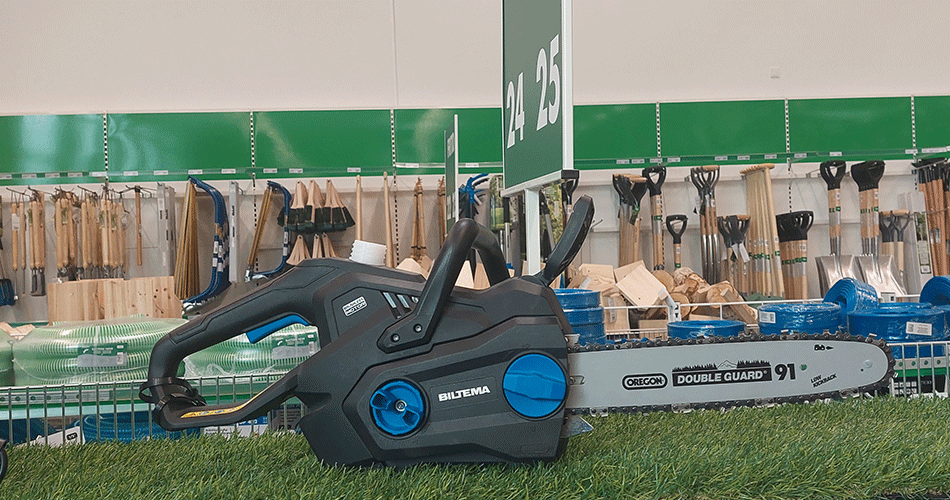Everything You Need to Know About Beech Hedge Trimming and Pruning
On this page, we provide our best tips and tricks so you can start trimming or pruning your beech hedge. We will tell you which tools to use, and you can also find out the best time of the year to trim a hedge. And we also give you step-by-step guides for both trimming and pruning beech hedging, because there is a difference between the two.
The difference between beech hedge trimming and pruning
When it comes to maintaining your beech hedge, it’s important to first understand the difference between trimming and pruning. Both play an important role in maintaining the appearance and health of the hedge, but the processes have different purposes, and they are not carried out equally often either.
Trimming a beech hedge is a normal maintenance task that you typically need to do twice a year. The purpose of trimming is to maintain both the shape of the hedge and its density, which is achieved by trimming the hedge regularly. The process itself typically involves trimming the sides and top of the hedge.
Pruning (referred to as rejuvenation or renewal pruning) a beech hedge is a different task that you do less frequently. In fact, it’s typically only every ten to fifteen years that you need to think about pruning your hedge. The purpose of pruning the hedge is to renew it and prevent it from becoming too tall and gangly. When pruning a beech hedge, it needs to be cut down significantly – often to about a metre in height. This makes room for new, fresh growth.
So even though both trimming and pruning are important for the maintenance of your beech hedge, the two processes are very different. And it’s important to know the difference.
When is the best time to trim a beech hedge?
One of the most searched questions among many garden owners is: When is the best time to trim a beech hedge? Knowing the right time to start trimming your beech hedge is crucial – both for the health of the hedge but also for its appearance. In general, we recommend that you trim your beech hedge twice a year – once in June and then again in late August or early September.
The trimming in June coincides with the growing period of the hedge. Here it is important to trim the hedge before it grows too tall and wild. By cutting the hedge in June, you give the hedge the opportunity to develop a nice shape, and you help ensure that it does not become too wild as it continues to grow over the summer.
In addition to trimming the beech hedge in June, you will need to trim it again in late summer, after the hedge has had a good growing season, so that it can maintain its shape and density throughout the winter.
Trimming a beech hedge too early or too late
What happens if you trim the hedge too early or too late? If you trim a beech hedge too early in the year, you risk damaging the new shoots that are about to sprout. This can actually weaken the hedge and make it less dense.
On the other hand, if you trim the hedge too late in the year, there’s a risk that the hedge will not fully recover before the cold of winter sets in. And this can result in a less robust hedge that is more vulnerable to both frost and disease.
It is therefore important to know exactly the right times trim your beech hedge, because the timing is very important. And by following the general guidelines for trimming the beech hedge in June and again in late summer, you can give your beech hedge optimal growing conditions.
What you need to trim your beech hedge
There are some essential tools you need to properly trim your beech hedge. First of all, you will need a hedge trimmer. Hedge trimmers come in many different models and sizes, and it is important to choose one that is suitable for the size of your hedge. An electric hedge trimmer is usually a good choice for smaller and medium-sized hedges, as it is easy to handle for most people. For larger hedges, a petrol-powered hedge trimmer can be an advantage as it is more powerful and can handle thicker branches.
In addition to a hedge trimmer, you also need good pruning shears or garden shears. You need this to cut the thicker branches, which the hedge trimmer may have difficulty cutting through.
When trimming your beech hedge, you will also need some personal protective equipment. A good pair of garden gloves will protect your hands from twigs and branches. Another good idea is to invest in a pair of safety glasses to protect your eyes.

Choose the right hedge trimmer
When you start trimming your beech hedge at home, it is important that you use a good hedge trimmer that suits both you and your hedge. At Biltema we have a wide range of hedge trimmers, and we have gathered a few tips that you can follow when choosing a hedge trimmer.
- First, consider the size of the hedge: When choosing a hedge trimmer for trimming beech hedging, you first and foremost need to look at the size of your hedge. If it is small or medium-sized, then an electric hedge trimmer can be a good choice, because it is easy to handle and good for smaller trimming jobs. On the other hand, if you have a large hedge, a petrol-powered hedge trimmer may be the right choice since it is more powerful and can handle the thicker branches.
- Check the trimmer weight: The weight of a hedge trimmer can have a big impact on how easy it is for you to handle when you get started. Therefore, choose a trimmer that you can easily lift and handle without any problems. If it is too heavy, trimming the hedge may prove challenging.
- Check the hedge trimmer blade length: Hedge trimmers come with different blade lengths. If your hedge is wide, a trimmer with a longer blade can be advantageous. On the other hand, if your hedge is narrow, a trimmer with a shorter blade may be sufficient.
- Check the trimmer battery life: If you choose a cordless hedge trimmer, pay attention to the battery life, because you don’t want to run out of power while trimming. Make sure you choose a model that has a sufficiently long battery life to handle the entire trimming job.
- Consider the trimmer noise level: Hedge trimmers can be noisy. Therefore, if you live close to neighbours, it may be a good idea to choose a trimmer with a low noise level to minimise disturbances as much as possible.
Before you start trimming the hedge, it’s good to spend time finding the right hedge trimmer for your beech hedge to ensure that trimming is as easy and efficient as possible, along with all the other things you need.
How to trim your beech hedge:
Does your beech hedge need trimming? Then there are several things you need to be aware of before, during, and after trimming your beech hedge. We have compiled a guide for you to get your project started.

Before trimming
Trimming a beech hedge requires good preparation to ensure that you achieve the best possible result.
- Check the weather: It may be a good idea to trim the hedge on a cloudy day, so that you don’t need to trim several metres of hedging under the blazing sun.
- Have the right tools: A hedge trimmer is ideal for trimming a beech hedge, so make sure you have the right tools before you get started.
- Safety first: Also, make sure to use safety gloves and safety glasses to protect yourself while trimming.
- Plan the trimming: It is important to have a plan for how the hedge will be trimmed. Therefore, consider the height, width, and shape of the hedge before starting the project.
How to trim
Once you are well prepared, it’s time to start trimming the hedge.
- Start from the bottom: Start trimming at the bottom of the hedge and slowly work your way up. This helps maintain the shape of the hedge and ensures that you don’t cut off too much at once.
- Create a slight slope: When trimming the hedge, you should cut it so that it is widest at the bottom. Do this by cutting inwards as you move the hedge trimmer upwards. This helps ensure that sunlight can reach all leaves, and you also get a denser hedge.
- Trim the hedge carefully: Don’t cut off too much at once. It is better to trim little by little and then trim more afterwards than to cut too much straight away.
- Look out for bird’s nests: During the breeding season, there may be bird’s nests hidden in the hedge. So, look out for nests so that you don’t disturb the birds in the middle of the breeding season.
What you should do after trimming
When you’re done trimming the hedge, you’ve come a long way, but there are still a few things you should take care of before you’re completely done.
- Clean your tools: Clean and maintain your tools when after trimming to make sure they’re ready for the next time.
- Remove all debris: Remove all cut branches and leaves from the hedge and the surrounding area. We recommend placing the debris in big bags and taking it to a refuse recycling centre.
- Water the hedge: After trimming the hedge, it may be somewhat stressed and strained. It is therefore a good idea to water it to help it recover.
- Fertilise the hedge: After trimming, it’s also good to give the hedge some fertiliser to help it start growing again.
Trimming a beech hedge is not difficult, but it requires preparation and care. And if you follow the steps above, then you are well on your way.
5 typical mistakes when trimming a beech hedge
When trimming your beech hedge, garden owners encounter several pitfalls. We have therefore compiled a list of the five most common mistakes that you should be aware of before you get started.
- Consider the time of the year: It is important to trim the hedge at the right times of the year, because trimming either too early or too late can negatively affect both the health and growth of the hedge.
- Consider your cutting technique: The hedge should be trimmed wider at the bottom than at the top. This ensures that sunlight can reach all parts of the hedge, and this is crucial for the hedge’s growth.
- Never use a dull hedge trimmer: A dull hedge trimmer can make cutting the hedge a long and hard process. And it can also damage the hedge and make it more vulnerable to disease.
- Don’t cut off too much: It is important not to cut too much of the hedge at once. Overtrimming can stress the hedge and make it more vulnerable to both diseases and pests. And then it won’t look very good.
- Don’t ignore signs of disease: If you notice signs of disease or pests, it is important that you act quickly. If you ignore the problem, it can quickly spread and end up damaging the entire hedge.
By avoiding these five common mistakes, your hedge trimming is more likely to be successful. So keep the pitfalls in mind before starting the project.
Trimming a brand new beech hedge
A newly planted beech hedge needs extra care and attention so that it can grow strong and healthy. And trimming the beech hedge plays an important role in this. If you have planted a new beech hedge, it’s important that you trim it correctly to ensure healthy and dense growth.
You should trim it already during the planting season, which is typically during spring. This trimming is crucial for the future shape and density of the hedge. When trimming your new hedge for the first time, you should start by cutting the top of the hedge so that all shoots are at an equal height. This will help give you a dense hedge down the line. Then trim the sides so that the hedge has a slight cone shape – wider at the bottom than at the top. This ensures that sunlight can reach all leaves, which is important for the health of the hedge.
After you have done the first trim, you should trim your beech hedge at least once a year. The best time is in late June or early July, when the hedge has had its first growth.
When is it time to prune the beech hedge?
Rejuvenation pruning a beech hedge is a major task that you don’t need to do nearly as often as ordinary trimming. In general, it is recommended for beech hedge to be pruned every ten to fifteen years. However, this may vary depending on the condition and growth of the hedge.
Rejuvenation pruning is usually necessary when the hedge has grown too high or too wide, or too dense at the bottom. It may also be necessary if the hedge has lost its shape or has become too gangly. Pruning the beech hedge thus helps to renew the hedge and ensures that it can continue to grow in a healthy and more controlled way.
The best time rejuvenation pruning is in early spring, before the hedge starts to sprout new shoots. At that point, the hedge is at rest, and the large wounds that result from cutting will have plenty of time to heal before the hedge begins to grow again.
When pruning, you typically need to prune the hedge to a height of about one metre. It may seem drastic, but this makes room for fresh new growth. After pruning, it will take a few years before the hedge is back to its full height and density.
How to prune your beech hedge correctly
Rejuvenation pruning a beech hedge may seem like a major project, but it’s all about the right techniques and having a good understanding of the process.

We have compiled a guide on how to prune your beech hedge:
- Have the right tools: When pruning your hedge, you need a sharp hedge trimmer, or a chainsaw if the hedge is very big. Make sure your tool is clean and sharp as this will make the job easier.
- Plan the pruning: Before you start the project, you should also decide how much you want to prune. A good rule of thumb is to give the hedge a heavy pruning down to about a metre’s height. This leaves room for new growth and makes it easier to maintain the hedge in the future.
- Start pruning: Start by pruning the sides of the hedge. It’s important to do this gradually so you don’t cut off too much at once. After pruning the sides, you can move to the top. You may need to use a ladder to reach the top of the hedge.
- Check the hedge: When pruning the hedge, you should check the hedge carefully and remove dead or diseased branches. This will help the hedge recover from the pruning.
- Care for the hedge after pruning: After pruning, it’s good to give the hedge extra care. Water it thoroughly and consider adding a little fertiliser so that it gets a good start in the new growing season.
Beech hedge pruning may seem difficult, but with the guide above and a good understanding of the whole process, it’s easy to get started when your hedge needs some care and maintenance.
Here you will find all Biltema’s hedge trimmers.



